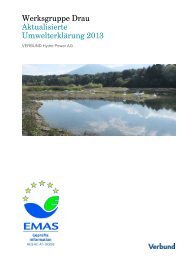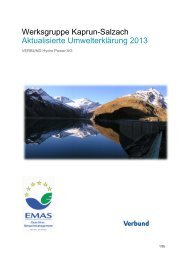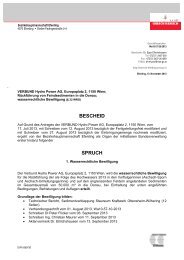Download PDF - Verbund
Download PDF - Verbund
Download PDF - Verbund
You also want an ePaper? Increase the reach of your titles
YUMPU automatically turns print PDFs into web optimized ePapers that Google loves.
The slope until 2006:<br />
the above-ground penstocks<br />
that brought water to the<br />
main stage in Kaprun.<br />
There’s nothing unusual at<br />
first glance. It almost<br />
looks like a slope<br />
with natural vegetation.<br />
We’re standing in the middle of a line route at<br />
1,200 metres above sea level. We see nothing.<br />
Nothing unusual. Trees, shrubs and little saplings<br />
all around. Our first question is, “Where’s the<br />
penstock?” The four old above-ground penstocks<br />
were dismantled in 2005 before the renaturation<br />
project began. “The goal of renaturation is to<br />
restore the ecosystem, so that in 10–15 years no<br />
one would ever know”, says Günther Töpfer of the<br />
project’s future course.<br />
TAKING IT ALL IN<br />
The power plants, main and upper stage, are an<br />
integral part of Kaprun’s storage power plants.<br />
The initial idea was to generate electricity with<br />
water from the mountains of Kaprun. In 1938,<br />
construction began on the power plant. After 14<br />
years, the main stage and then the upper stage<br />
were ceremoniously opened. The water has to<br />
travel 800 metres down from the valve chamber<br />
at Maiskogel before it reaches the power station<br />
STUDENTS REPORT: RE-NATURATION OF PENSTOKES IN KAPRUN | SUSTAINABILITY REPORT 2009 | 33<br />
in the valley. There were four above-ground<br />
penstocks that were placed on concrete blocks<br />
at regular intervals. During routine inspections,<br />
technical defects were found in the penstocks and<br />
their welded seams. The reason for the technical<br />
problem was that the steel production and the<br />
seams had been done during and shortly after the<br />
war, so the quality was less than optimal. For that<br />
reason, the remaining operational time of these<br />
penstocks was set for 2003. As a replacement, an<br />
underground inclined shaft was built in 2004.<br />
The advantage of a pressure shaft is that the<br />
water pressure is handled by the mountain, so<br />
thinner pipes can be used. After completion of the<br />
inclined shaft in 2004, work immediately began on<br />
dismantling the above-ground penstocks and renaturation<br />
of the route.<br />
AT A GLANCE AND IN DETAIL<br />
As we look up at the sky, the sun takes a quick<br />
peek out from the clouds, blinding us. We search

















